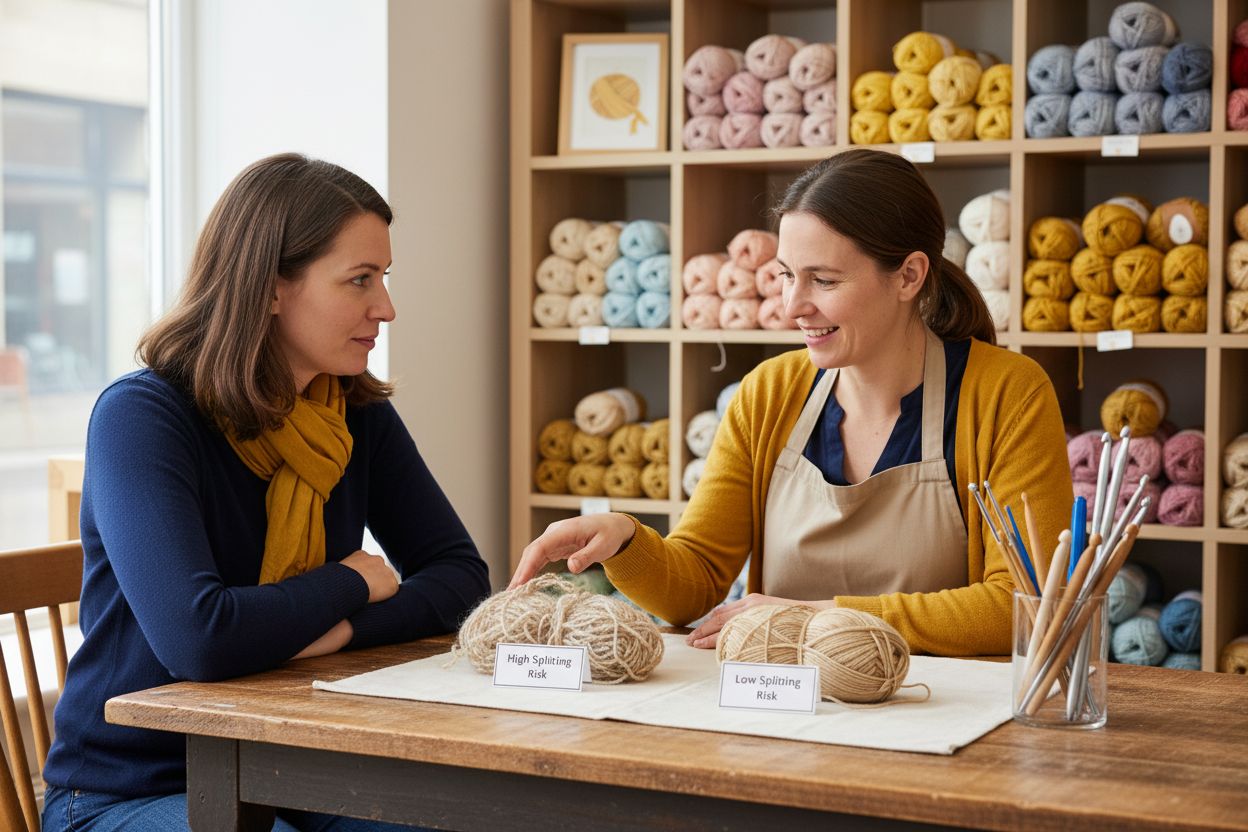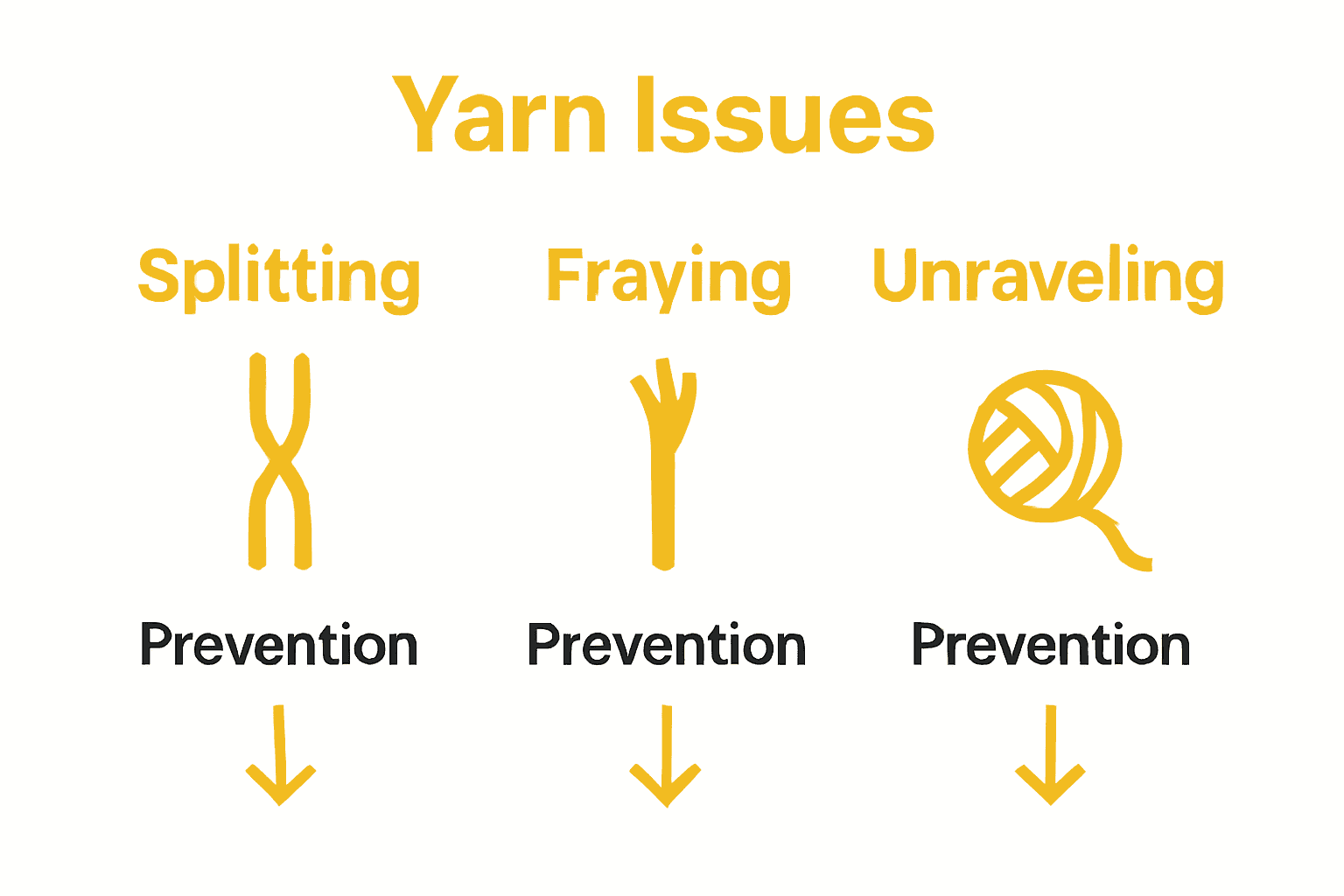
What Is Splitting Yarn? Complete Guide for Crafters
Have you ever noticed your crochet hook snagging part of your yarn, leaving uneven stitches or loose loops? Studies show that yarn splitting is one of the top reasons projects stall or unravel. For anyone who crochets or knits, understanding why yarn splits helps you avoid wasted hours and frustrating do-overs. Discover how small shifts in materials and technique can make a big difference in keeping your stitches neat and your projects stress-free.
Key Takeaways
| Point | Details |
|---|---|
| Understanding Yarn Splitting | Yarn splitting occurs when crafting tools catch portions of yarn strands, influenced by yarn quality, tool compatibility, and crafting technique. |
| Yarn Type and Construction | Different yarn types and their construction (spin quality and twist direction) greatly affect their propensity to split, with tightly spun yarns being less prone to issues. |
| Preventive Strategies | Crafters can minimize splitting by selecting suitable yarns, using compatible tools, and maintaining consistent tension while crafting. |
| Recognizing Yarn Issues | Distinguishing between yarn splitting and other issues, such as fraying or unraveling, is essential for applying the appropriate solutions during crafting. |
Table of Contents
- Defining Splitting Yarn In Crochet And Knitting
- Common Causes And Types Of Yarn Splitting
- How Yarn Construction Affects Splitting Risk
- Preventing And Minimizing Yarn Splitting Issues
- Essential Tips For Choosing The Right Yarn
- Comparison: Splitting Yarn Versus Other Issues
Defining Splitting Yarn in Crochet and Knitting
Yarn splitting is a common frustration for crafters that occurs when your crochet hook or knitting needle catches only a portion of the yarn strand instead of the entire strand. According to research from CyCrochet, this phenomenon happens due to several technical factors in yarn preparation and crafting technique.
The root causes of yarn splitting are multifaceted. LiveToPlant’s research highlights three primary contributors:
- Yarn Spin Quality: Loosely spun yarns with weak fiber connections are more prone to splitting
- Hook/Needle Compatibility: Using an inappropriate hook or needle size can increase splitting risks
- Crafting Technique: Rushing through stitches or not carefully catching full yarn loops
Understanding yarn splitting isn’t just about recognizing the problem, but comprehending its nuanced mechanics. Different yarn types – from delicate merino wools to sturdy cotton blends – have varying levels of vulnerability. A silk-blend yarn will behave differently from a tightly spun acrylic, making technique and tool selection crucial in preventing this crafting challenge. Read more about yarn techniques in our comprehensive guide.
For crafters, yarn splitting represents more than a technical hiccup – it’s a skill refinement opportunity. By understanding your materials, practicing deliberate techniques, and selecting appropriate tools, you can transform this potential frustration into a mastery of your craft.
Common Causes and Types of Yarn Splitting
Yarn splitting emerges from a complex interplay of fiber characteristics and crafting techniques. According to LiveToPlant’s research, the primary culprits include loosely spun yarns, incompatible hooks, and irregular crafting tension that compromise yarn integrity.
The technical landscape of yarn splitting reveals several distinct types:
- Single-Ply Vulnerability: Yarns with fewer twists are more susceptible to separating during crafting
- Twist Direction Complications: S‑ or Z‑twist yarns can split differently depending on crochet or knitting direction
- Hook Tip Precision: Overly sharp or pointed hook tips increase the likelihood of piercing yarn strands
Research from CyCrochet highlights that yarn manufacturing plays a crucial role in splitting potential. Explore how yarn quality impacts your crafting experience, as the manufacturing process directly influences a yarn’s structural integrity and resistance to splitting.
Understanding these nuanced causes empowers crafters to make informed choices. By selecting well-spun yarns, matching appropriate tools, and developing consistent techniques, you can significantly reduce the frustrating experience of yarn splitting.
How Yarn Construction Affects Splitting Risk
Yarn construction plays a critical role in determining a fiber’s propensity to split during crafting. According to research from CyCrochet, the spin quality and tightness are fundamental factors that influence a yarn’s structural integrity. Tightly spun yarns demonstrate significantly greater resistance to splitting compared to loosely spun alternatives, especially in eco-friendly or recycled fiber types.
The twist direction of yarn introduces another fascinating complexity to splitting risks. Crochet Australia’s research reveals intricate dynamics between yarn twist types:
- S-Twist Yarns: More common, but can untwist during crocheting, increasing splitting potential
- Z-Twist Yarns: Tend to reinforce their own twist, potentially reducing splitting risks
- Twist Density: Tighter twists generally provide more structural stability
Understanding these nuanced construction characteristics becomes crucial for crafters seeking consistent, high-quality results. Learn more about yarn characteristics in our comprehensive guide, where the intricate world of yarn manufacturing meets practical crafting techniques.
By recognizing how different spinning techniques, fiber types, and twist directions interact, crafters can make more informed yarn selections. The right yarn construction not only minimizes splitting but also enhances the overall quality and durability of your crafting projects.
Here’s a comparison of how different yarn constructions affect splitting risk:
| Yarn Type | Splitting Risk | Twist Direction Effect | Best Use Case |
|---|---|---|---|
| Loosely Spun Wool | High | Easily untwists (S-twist) | Soft projects, handle gently |
| Tightly Spun Acrylic | Low | Retains twist (Z-twist) | Beginner projects, durability |
| Cotton Blend | Moderate | Can split if too firm | Dishcloths, structural items |
| Silk-Blend | Moderate-High | Very slick, can separate | Luxury items, careful technique needed |
Preventing and Minimizing Yarn Splitting Issues
Preventing yarn splitting requires a strategic approach that combines thoughtful material selection and refined crafting techniques. According to LiveToPlant’s research, crafters can significantly reduce splitting by making intentional choices about their materials and methods.
Key strategies for minimizing splitting include:
- Yarn Selection: Choose tightly plied yarns and avoid highly textured or novelty yarns
- Hook Compatibility: Use smooth, rounded hooks with appropriate sizing for your yarn
- Technique Refinement: Maintain consistent tension and carefully insert hooks under full loops
- Work Pace: Slow down your crafting to improve precision and reduce accidental splitting
Research from CyCrochet suggests additional nuanced techniques, such as matching yarn end or ball pull direction to the yarn’s original twist and experimenting with different pulling techniques. Learn more about optimizing your yarn storage and handling to further reduce splitting risks.
Ultimately, preventing yarn splitting is an art of patience and practice. By understanding your materials, investing in quality tools, and developing mindful crafting techniques, you can transform potential frustrations into smooth, enjoyable creative experiences.

Essential Tips for Choosing the Right Yarn
Yarn selection is a critical skill that can dramatically impact your crafting success. According to LiveToPlant’s research, beginners should prioritize specific characteristics to minimize splitting and ensure a smooth crafting experience. Tightly plied, smooth worsted or DK weight yarns emerge as top recommendations for those looking to reduce potential crafting frustrations.
Fiber content plays a crucial role in yarn performance and splitting potential:
- Acrylic Yarns: Generally smoother and less prone to splitting
- Cotton Yarns: Can be firm but potentially more harsh on hooks
- Wool Blends: Often provide a balanced combination of softness and structure
- Twist Density: Tighter twists consistently offer better structural integrity
Crochet Australia’s research highlights an additional nuanced consideration: twist direction compatibility. Right-handed crocheters may benefit from Z-twist yarns, which help maintain yarn twist and reduce splitting risks. Explore our comprehensive guide on selecting the perfect yarn to further refine your understanding.
Choosing the right yarn is more than a technical decision—it’s about understanding how fiber characteristics interact with your specific crafting technique. By paying attention to twist, weight, and fiber composition, you can select yarns that not only prevent splitting but also enhance your overall crafting experience.
Comparison: Splitting Yarn Versus Other Issues
Yarn issues are not created equal, and understanding their distinct characteristics is crucial for effective crafting. According to LiveToPlant’s research, splitting represents a unique challenge where individual plies are caught separately, fundamentally different from other yarn-related problems like fraying or unraveling.
Key distinctions between yarn problems include:
- Splitting: Mechanical issue involving individual strand separation
- Fraying: Fiber ends loosening or becoming fuzzy, typically at yarn edges
- Unraveling: Complete loss of yarn twist or structural integrity
- Pilling: Surface fiber buildup causing rough texture
Mary Maxim’s research highlights that fraying prevention differs significantly from splitting solutions. Each yarn issue requires a targeted approach. Learn more about managing yarn length and quality to better understand these nuanced challenges.
While splitting, fraying, and unraveling might seem similar, they stem from distinct causes and demand unique prevention strategies. Recognizing these differences empowers crafters to diagnose and address yarn problems more effectively, ensuring smoother, more enjoyable crafting experiences.

Ready to Craft Without the Frustration of Yarn Splitting?
You have spent time learning about yarn splitting and how it can disrupt your creative flow and impact the look of your crochet or knitting projects. Selecting the right yarn with a strong, reliable spin and proper fiber content is essential to eliminate the struggle with splitting and keep your stitches consistent and beautiful. At CRAFTISS Yarn, we offer a wide range of carefully chosen fibers designed to help you avoid the risk of splitting and reach your crafting goals faster.
.png)
Stop letting yarn splitting hold you back from enjoying your favorite hobby. Explore our handpicked yarn selection, trusted by crafters just like you, and discover tools that make a real difference. Visit our Yarn collection or browse our main site to start your next project with confidence. Want to keep your supplies organized and in perfect shape? Find the right match for your style in our Yarn Bags section. Shop now so you can enjoy smooth, split-free crafting every time you pick up your hook or needles.
Frequently Asked Questions
What causes yarn to split during crochet or knitting?
Yarn splitting typically occurs when the hook or needle catches only a part of the yarn strand. Common causes include loosely spun yarns, incompatible hooks or needles, and irregular crafting tension.
How can I prevent my yarn from splitting while I craft?
To minimize yarn splitting, select tightly plied yarns, use smooth and appropriately sized hooks or needles, maintain consistent tension, and work deliberately to ensure you catch full loops of yarn.
What types of yarn are more prone to splitting?
Single-ply yarns and loosely spun fibers are generally more susceptible to splitting. Additionally, yarns with specific twist directions can behave differently, with S-twist yarns often having a higher chance of splitting when crocheted or knitted in certain directions.
How does yarn construction affect its splitting risk?
The construction of yarn—specifically its ply twist and spin quality—significantly impacts its tendency to split. Tightly spun yarns resist splitting better than loosely spun alternatives, and the twist direction can also influence how the yarn behaves during crafting.


